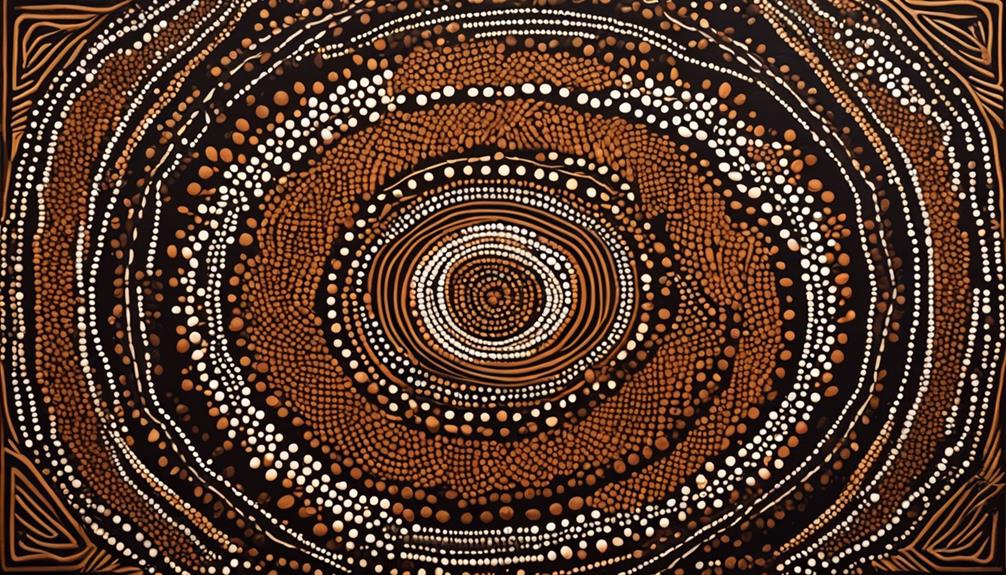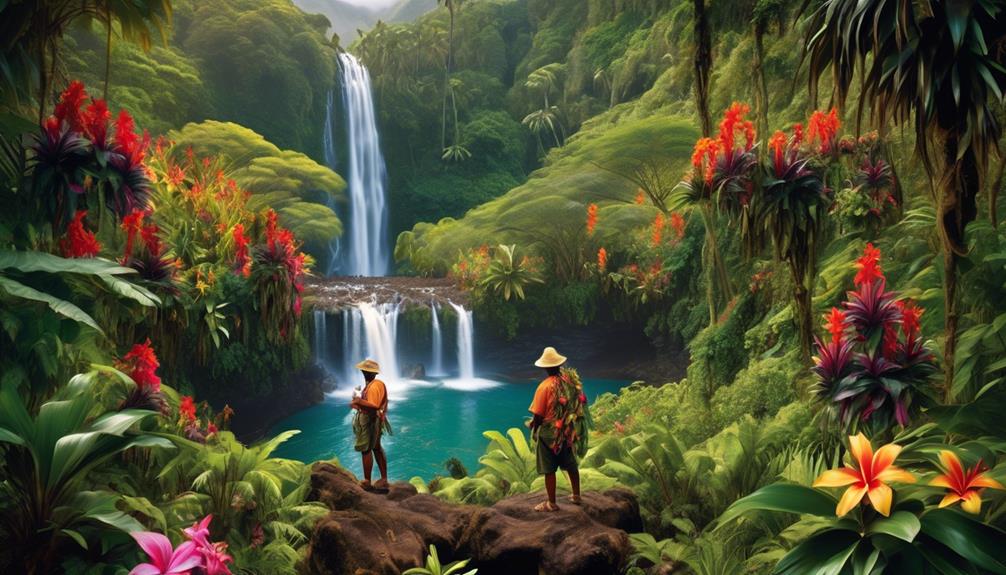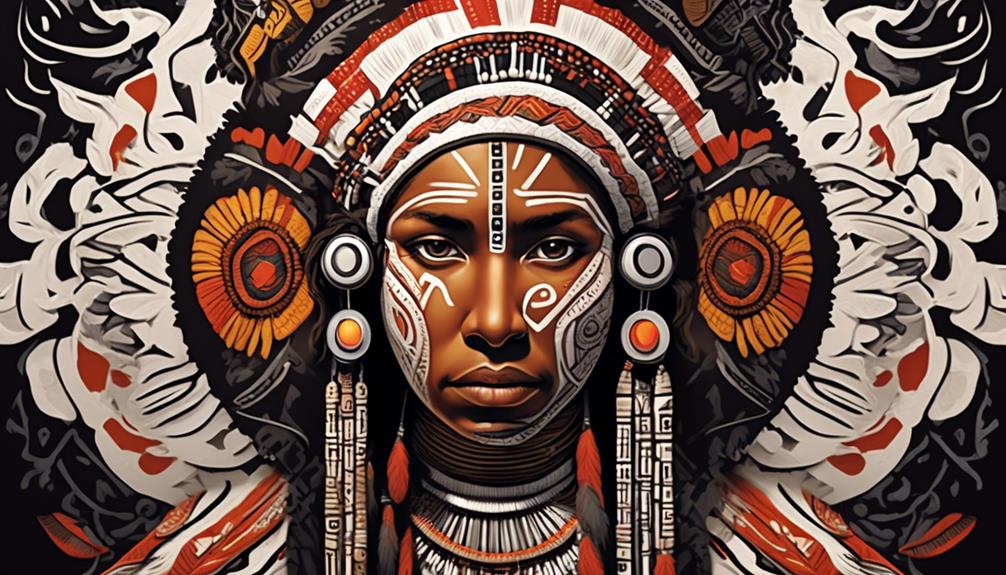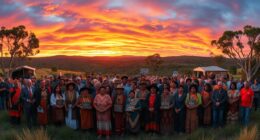Exploring the world of Aboriginal art concepts reveals a wealth of creative possibilities. Dot painting, art featuring indigenous symbols, and pieces inspired by the natural world offer a wide range of avenues for artistic discovery.
But what about easy Aboriginal art ideas for kids? And how can we incorporate Aboriginal art onto rocks?
Join us as we uncover simple yet captivating ways to bring the beauty of Aboriginal art into our creative endeavors.
Key Takeaways
- Dot painting with vibrant colored paints and round-tipped brushes is an easy and accessible Aboriginal art technique for kids.
- Handprint art incorporating traditional symbols and patterns is a great way to introduce children to Aboriginal art and storytelling.
- Rock painting serves as a form of cultural storytelling, using natural pigments and dyes to depict Indigenous symbols and daily life.
- Aboriginal art reflects a deep connection to the natural world, with color palettes inspired by the earthy tones of the outback and vibrant hues of native flora.
Dot Painting Techniques
Dot painting techniques, commonly used in Aboriginal art, involve the meticulous application of small dots to create intricate and visually captivating designs. Color mixing plays a critical role in dot painting, as it allows for the creation of a wide range of hues and shades from a limited palette.
By skillfully blending primary colors, artists can achieve a spectrum of secondary and tertiary colors, adding depth and vibrancy to their artwork. The deliberate and precise dot placement is another fundamental aspect of this technique. Artists must carefully consider the arrangement of each dot to form patterns, symbols, and stories that hold cultural significance.
The spacing and size of the dots contribute to the overall visual impact of the artwork, creating rhythm and movement within the designs. Understanding the significance of each dot and its placement is essential for mastering this technique.
Through a thoughtful combination of color mixing and dot placement, artists can produce mesmerizing pieces that not only showcase their technical prowess but also convey rich cultural narratives.
Indigenous Symbol Inspired Art
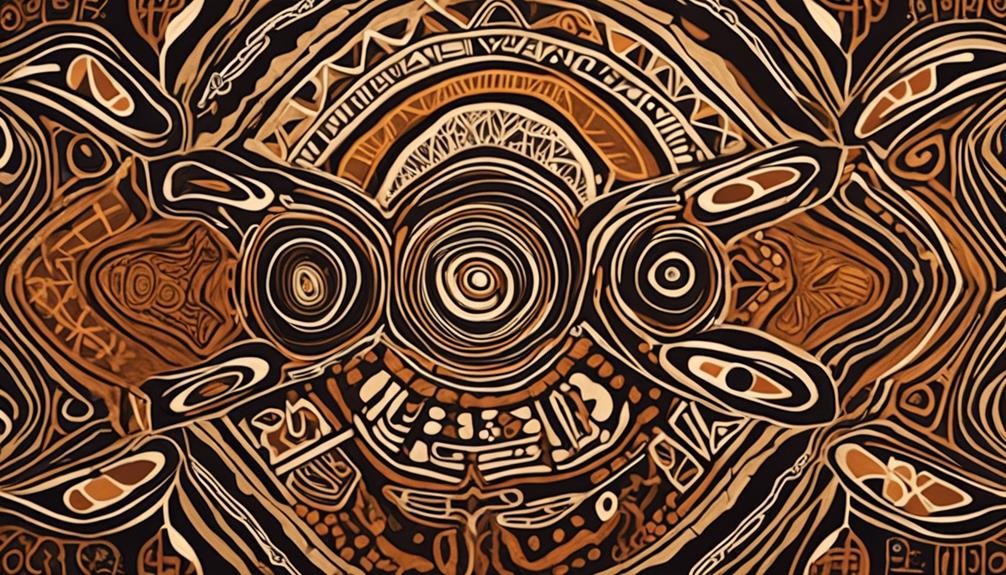
Exploring the artistic heritage of Aboriginal cultures, the use of indigenous symbols in art offers a profound connection to cultural narratives and traditions, expanding the visual storytelling beyond the intricate dot painting techniques. Indigenous symbols are a cornerstone of Aboriginal art, representing the interconnectedness of the land, ancestral stories, and spiritual beliefs. When incorporating these symbols into art, it's essential to understand their meanings and significance, ensuring the respectful portrayal of cultural motifs.
Traditional techniques such as cross-hatching and rarrk designs are employed to infuse depth and complexity into the artwork, showcasing the rich artistic traditions passed down through generations.
- Meaningful Representation
- Indigenous symbols serve as a visual language, communicating stories of creation, survival, and the interconnectedness of all living things.
- Each symbol holds specific meanings and is deeply rooted in the cultural and spiritual landscape of Aboriginal communities.
- Artistic Techniques
- Traditional methods like x-ray art, depicting internal organs and skeletal structures of animals, are utilized to convey a deeper understanding of the natural world.
- The use of ochre pigments and natural materials pays homage to age-old practices, connecting the artwork to the land and its resources.
Nature-Inspired Aboriginal Art
Drawing inspiration from the diverse landscapes and ecosystems of Australia, Aboriginal art intricately weaves together the natural world and cultural narratives. Nature-inspired Aboriginal art captures the essence of the land, its creatures, and the interconnectedness of Indigenous peoples with their environment. The color palettes utilized in these artworks are often derived from the earthy tones of the outback, the vibrant hues of native flora, and the deep blues and turquoises of the surrounding oceans. These color choices not only reflect the natural environment but also hold deep Indigenous cultural significance. For instance, the ochre tones represent the earth and are often used in ceremonial contexts, while the blues may symbolize water, essential for sustaining life in the arid Australian landscape. Additionally, the use of natural pigments and materials in creating these artworks further emphasizes the connection to the land and its resources. This nature-inspired approach to Aboriginal art serves as a visual expression of the profound relationship between Indigenous Australians and the natural world.
| Nature-Inspired Color Palettes | Indigenous Cultural Significance | Artworks |
|---|---|---|
| Earthy tones of the outback | Representation of the land | Dot paintings |
| Vibrant hues of native flora | Symbolism of native plants | Bark paintings |
| Deep blues and turquoises | Depiction of water sources | Rock art |
Easy Aboriginal Art for Kids
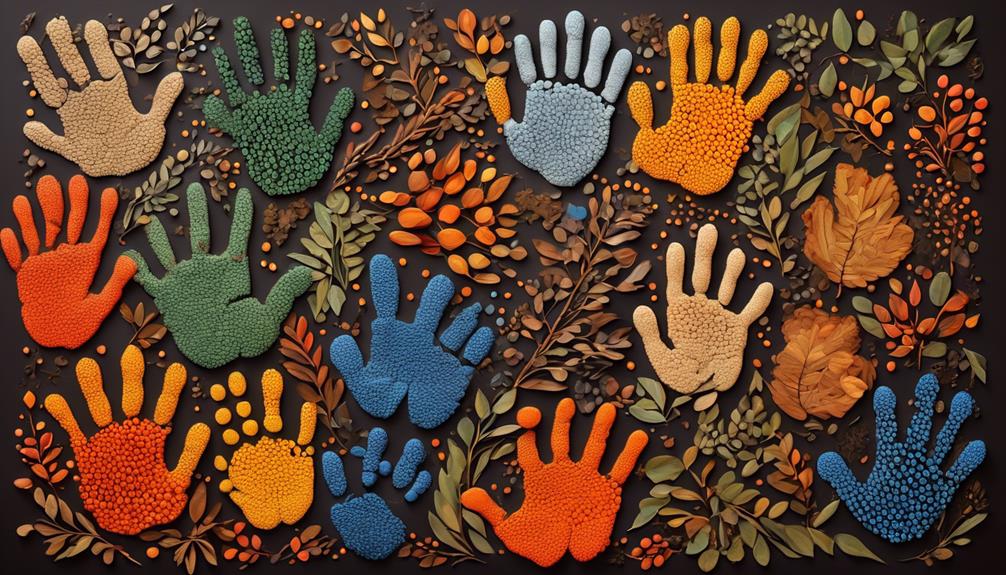
Considering the rich cultural heritage of Aboriginal art, it's fascinating to explore accessible and engaging art projects for children that draw inspiration from this tradition. Easy Aboriginal art for kids serves as a wonderful introduction to the cultural significance and colorful techniques of Aboriginal art.
Here are some simple and enjoyable ideas to get kids started on their Aboriginal art journey:
- Dot Painting:
- *Materials*: Provide children with a variety of vibrant colored paints and round-tipped brushes.
- *Technique*: Encourage them to create intricate patterns and designs using small, uniform dots. This activity not only enhances fine motor skills but also introduces the concept of storytelling through symbols and colors.
- Handprint Art:
- *Materials*: Use non-toxic, washable paint and a large sheet of paper.
- *Technique*: Guide children to create handprint artworks, incorporating traditional Aboriginal symbols and patterns. This activity not only allows kids to explore their creativity but also teaches them about the cultural significance of handprints in Aboriginal art.
These activities provide a hands-on approach for kids to appreciate and learn about the cultural significance and vibrant techniques of Aboriginal art.
Aboriginal Art on Rocks
Indigenous Australians have a long-standing tradition of creating intricate and meaningful art on rocks, showcasing their cultural stories and connection to the land. Rock painting is a significant aspect of Aboriginal art, serving as a form of cultural storytelling that depicts the traditions, beliefs, and history of their people. The use of natural pigments and dyes to create these artworks on rocks has been a tradition passed down through generations, reflecting the deep spiritual connection to the land and the preservation of their cultural heritage.
| Rock Painting Ideas | Cultural Storytelling |
|---|---|
| Use of natural pigments | Depicting Dreamtime stories |
| Indigenous symbols | Connecting to the land |
| Traditional techniques | Preserving cultural heritage |
The rock paintings often feature Indigenous symbols that represent elements of their daily lives, such as hunting, gathering, and ceremonial rituals. These artworks are not only visually striking but also hold deep cultural significance, making them a valuable source of knowledge about Aboriginal traditions and history. The practice of rock painting continues to be an essential means of passing down cultural knowledge and maintaining a strong connection to the land for Indigenous Australians.
Frequently Asked Questions
Can You Recommend Any Specific Aboriginal Artists for Further Inspiration?
We can recommend several contemporary Aboriginal artists for further inspiration.
Their work reflects a blend of traditional Indigenous art and modern influences, resulting in captivating pieces that resonate with cultural significance.
Some artists to explore include Emily Kame Kngwarreye, Clifford Possum Tjapaltjarri, and Rover Thomas.
Their unique styles and innovative approaches provide valuable insights into the ongoing evolution of Aboriginal art, making them excellent sources of contemporary inspiration.
What Are Some Traditional Aboriginal Art Materials and Where Can They Be Sourced?
When it comes to sourcing materials for traditional Aboriginal art, natural elements like ochre, tree bark, and feathers are commonly used. These materials can often be found in local landscapes or can be purchased from art supply stores that specialize in indigenous art materials.
Traditional techniques involve using these materials to create intricate dot paintings, bark paintings, and other forms of storytelling through art.
Are There Any Specific Cultural or Spiritual Considerations to Keep in Mind When Creating Aboriginal-Inspired Art?
When creating aboriginal-inspired art, cultural sensitivity is crucial. We must consider the artistic expression within the context of its spiritual significance and the ethical inspiration behind it.
Understanding the cultural and spiritual beliefs of the Aboriginal people is essential to ensure that the art is respectful and honors their traditions. By keeping these considerations in mind, we can create art that's both meaningful and culturally appropriate.
How Can I Respectfully Incorporate Aboriginal Art Into My Own Work Without Appropriating the Culture?
When it comes to respectfully incorporating Aboriginal art into our work, cultural sensitivity is key. We can seek respectful inspiration from the art while acknowledging and honoring its cultural significance.
Understanding the history and meaning behind the art can guide our approach, ensuring that we avoid appropriating the culture.
Can You Provide Any Tips for Displaying and Preserving Aboriginal Art in a Respectful Manner?
When it comes to displaying and preserving art, it's important to approach it with respect and cultural appreciation. Properly showcasing Aboriginal art involves understanding its significance and ensuring it's presented in a way that honors its origins.
Preservation methods should be carefully chosen to safeguard the integrity of the artwork and its cultural value. Respectful representation of this art form requires thoughtful consideration of its historical and cultural context.
Conclusion
So there you have it, folks! With these easy Aboriginal art ideas, you'll be able to create beautiful and meaningful artwork in no time.
Whether you're trying dot painting techniques, drawing inspiration from indigenous symbols, or creating nature-inspired art, the possibilities are endless.
And don't forget to get the kids involved with some easy Aboriginal art projects for them.
So grab your paintbrushes and get ready to unleash your creativity with these simple yet impactful Aboriginal art ideas!
